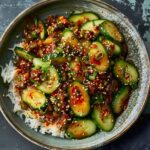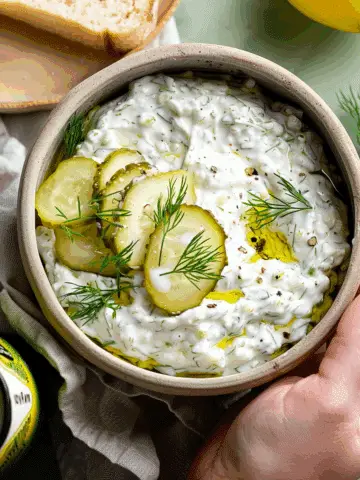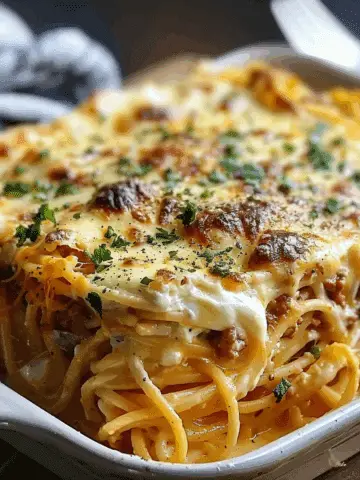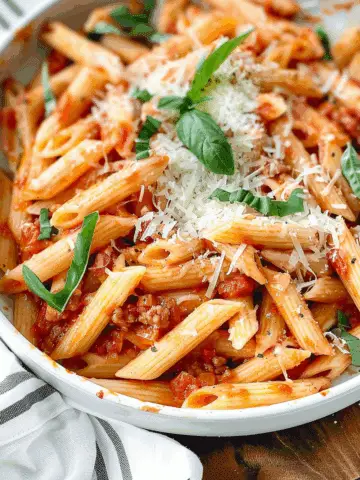Why You’ll Love This Recipe
This Korean Cucumber Salad is a delightful blend of flavors and textures. The cucumbers provide a satisfying crunch, while the dressing offers a harmonious balance of heat from gochugaru (Korean red pepper flakes), the umami of soy sauce, and the nutty aroma of toasted sesame oil. It's quick to prepare, requiring no cooking, and can be made in advance, allowing the flavors to meld beautifully. Whether you're serving it alongside grilled meats or enjoying it as a light snack, this salad is sure to impress.

Ingredients
(Tip: You'll find the full list of ingredients and measurements in the recipe card below.)
-
1 cucumber (Japanese, English, or Persian)
-
1 tablespoon soy sauce
-
2 tablespoons rice vinegar
-
1 tablespoon sugar
-
½ teaspoon Korean red chili powder (gochugaru)
-
¼ teaspoon sesame seeds
-
2 green onions, chopped
Directions
-
Slice the cucumber into thin rounds, approximately ⅛ inch (3 mm) thick.
-
In a bowl, combine the soy sauce, rice vinegar, and sugar.
-
Add the sliced cucumbers to the bowl and mix gently to coat.
-
Sprinkle in the gochugaru and sesame seeds, and toss to combine.
-
Add the chopped green onions and give the salad one final toss.
-
Let the salad sit for about 10-15 minutes to allow the flavors to meld before serving.
Servings and Timing
-
Servings: 2
-
Prep Time: 5 minutes
-
Total Time: 5 minutes
Variations
-
Garlic Addition: Incorporate 1 minced garlic clove for an added depth of flavor.
-
Sweetness Adjustment: Increase or decrease the sugar to suit your taste preferences.
-
Onion Options: Use thinly sliced sweet onions or shallots for a milder taste.
-
Spice Level: Adjust the amount of gochugaru to control the heat.
-
Herb Garnish: Top with fresh cilantro or mint for a fragrant twist.
-
Additional Vegetables: Add thinly sliced carrots or bell peppers for extra color and crunch.
-
Protein Boost: Mix in cooked edamame or tofu cubes for a more substantial dish.
-
Noodle Salad: Toss the salad with cold soba noodles for a refreshing meal.
-
Pickled Version: Allow the salad to marinate longer for a more pronounced pickled flavor.
-
Vegan Option: Use tamari instead of soy sauce to make it gluten-free.
Storage/Reheating
Store any leftover Korean Cucumber Salad in an airtight container in the refrigerator. For optimal freshness and crunch, consume within 2 days. The salad is best enjoyed cold and does not require reheating.
FAQs
What type of cucumber is best for this salad?
Japanese, English, or Persian cucumbers are ideal due to their thin skins and minimal seeds.
Can I make this salad in advance?
Yes, preparing the salad 10-15 minutes ahead of time allows the flavors to meld and enhances the taste.
Is this salad spicy?
The level of spiciness can be adjusted by varying the amount of gochugaru used. Start with a small amount and add more to taste.
Can I substitute rice vinegar with another type?
Yes, apple cider vinegar can be used as a substitute for rice vinegar.
Is this salad gluten-free?
If you use tamari instead of soy sauce, the salad can be made gluten-free.
How long will the salad stay fresh?
For the best taste and texture, consume the salad within 2 days of preparation.
Can I add other vegetables to this salad?
Yes, thinly sliced carrots or bell peppers can be added for extra color and crunch.
Is it necessary to salt the cucumbers before preparing the salad?
Salting the cucumbers and letting them sit for 10-15 minutes can help draw out excess moisture, resulting in a crisper salad.
Can I use regular sesame oil instead of toasted sesame oil?
Toasted sesame oil adds a distinct nutty flavor that enhances the salad. Regular sesame oil lacks this depth and is not recommended.
Can I make this salad vegan?
Yes, by using tamari instead of soy sauce, the salad can be made vegan and gluten-free.
Conclusion
Korean Cucumber Salad (Oi Muchim) is a delightful and easy-to-make dish that brings a burst of flavor to any meal. Its refreshing crunch and balanced seasoning make it a versatile side that pairs well with a variety of main courses. Whether you're new to Korean cuisine or a seasoned enthusiast, this salad is sure to become a favorite addition to your culinary repertoire.
Korean Cucumber Salad (Oi Muchim)
Korean Cucumber Salad, known as Oi Muchim, is a vibrant and refreshing side dish that combines cucumbers with a tangy, spicy, and slightly sweet dressing. It's quick to prepare and perfect as an accompaniment to any meal.
- Prep Time: 5 minutes
- Cook Time: 0 minutes
- Total Time: 5 minutes
- Yield: 2 servings
- Category: Side Dish
- Method: No-Cook
- Cuisine: Korean
- Diet: Vegan
Ingredients
1 cucumber (Japanese, English, or Persian)
1 tablespoon soy sauce
2 tablespoons rice vinegar
1 tablespoon sugar
½ teaspoon Korean red chili powder (gochugaru)
¼ teaspoon sesame seeds
2 green onions, chopped
Instructions
- Slice the cucumber into thin rounds, approximately ⅛ inch (3 mm) thick.
- In a bowl, combine the soy sauce, rice vinegar, and sugar.
- Add the sliced cucumbers to the bowl and mix gently to coat.
- Sprinkle in the gochugaru and sesame seeds, and toss to combine.
- Add the chopped green onions and give the salad one final toss.
- Let the salad sit for about 10-15 minutes to allow the flavors to meld before serving.
Notes
- Garlic Addition: Incorporate 1 minced garlic clove for an added depth of flavor.
- Sweetness Adjustment: Increase or decrease the sugar to suit your taste preferences.
- Onion Options: Use thinly sliced sweet onions or shallots for a milder taste.
- Spice Level: Adjust the amount of gochugaru to control the heat.
- Herb Garnish: Top with fresh cilantro or mint for a fragrant twist.
- Additional Vegetables: Add thinly sliced carrots or bell peppers for extra color and crunch.
- Protein Boost: Mix in cooked edamame or tofu cubes for a more substantial dish.
- Noodle Salad: Toss the salad with cold soba noodles for a refreshing meal.
- Pickled Version: Allow the salad to marinate longer for a more pronounced pickled flavor.
- Vegan Option: Use tamari instead of soy sauce to make it gluten-free.
Nutrition
- Serving Size: 1 serving
- Calories: 40
- Sugar: 5g
- Sodium: 500mg
- Fat: 2g
- Saturated Fat: 0g
- Unsaturated Fat: 2g
- Trans Fat: 0g
- Carbohydrates: 6g
- Fiber: 1g
- Protein: 1g
- Cholesterol: 0mg







Leave a Reply